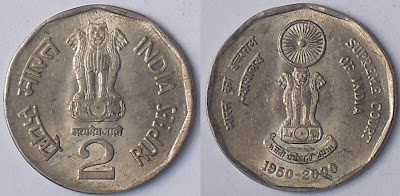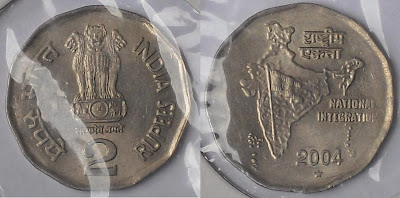2 rupee, supreme court of India
 The symbolism on the reverse: on the centre there is the four headed lion capital taken from the original sculpture which was erected around 250 BC atop an Ashoka pillar at Sarnath, and is now preserved at a museum in Sarnath. The sculpture was sculpted in sandstone and has been adopted as the national symbol of India. at the base of the symbol, there is a horse on the left and a bull on the right, and in the middle there is Ashoka chakra, which can also be found on the centre of the Indian flag.
The symbolism on the reverse: on the centre there is the four headed lion capital taken from the original sculpture which was erected around 250 BC atop an Ashoka pillar at Sarnath, and is now preserved at a museum in Sarnath. The sculpture was sculpted in sandstone and has been adopted as the national symbol of India. at the base of the symbol, there is a horse on the left and a bull on the right, and in the middle there is Ashoka chakra, which can also be found on the centre of the Indian flag.Above the lion capital we can see the Ashoka chakra, which is a depiction of the Dharmachakra, or the wheel of dharma. It has 24 spokes and it symbolizes the teachings of lord Buddha. The Ashoka chakra has been widely inscribed on many relics of the Mauryan emperor Ashoka the great including the lion capital and the Ashoka pillar, and it also finds its way on the Indian flag. The Ashoka chakra award is an Indian decoration award for soldiers who show exemplary bravery on the field of battle.
The lettering on the right reads "supreme court of India", and the lettering on the left in Hindi reads "Bharat ka ucchatam nyayalay" which means the same thing. The lettering below the lion capital reads "yato dharmastato jaya" in Sanskrit, which means that where there is virtue or Dharma, there is victory; thus enshrouding the principle that is the bottomline for any court of jutice: May the truth triumph! This line is taken from the Mahabharata where it is said by Gandhari.
The supreme court of India: The Supreme Court in India is the ultimate interpreter of the constitution and the laws of the land. It has appellate jurisdiction over all civil and criminal proceedings involving substantial issues concerning the interpretation of the constitution. The court has the original and exclusive jurisdiction to resolve disputes between the central government and one or more states and union territories as well as between different states and union territories. And the Supreme Court is also empowered to issue advisory rulings on issues referred to it by the president. The Supreme Court has wide discretionary powers to hear special appeals on any matter from any court except those of the armed services. It also functions as a court of record and supervises every high court.
2 rupee, 2004
 The 2 rupee was minted in the shown design until 2004, when because of rise in the metal prices, the mintage of this 2 rupee coin was stopped and the new 2 rupee coin with the cross design was started to be minted. Also, a majority of the shown 2 rupee coins of 2004 were melted back into the base metal because of the higher metal base values. This makes the 2004 2 rupee coin a rare one.
The 2 rupee was minted in the shown design until 2004, when because of rise in the metal prices, the mintage of this 2 rupee coin was stopped and the new 2 rupee coin with the cross design was started to be minted. Also, a majority of the shown 2 rupee coins of 2004 were melted back into the base metal because of the higher metal base values. This makes the 2004 2 rupee coin a rare one.
2 rupee, 2000

The theme for the 2 rupee coin has been national integration since the inception of the 2 rupee coin in 1982, and the design continued till 2004 when the controversial 2 rupee with the cross was introduced. The reverse on this coin shows the denomination, country and the four headed lion symbol. The obverse shows the map of India. The small dots on the left are the Lakshadweep Islands, and the line of dots below the "national integration" inscription and the Andaman and Nicobar Islands. The Hindi inscription above the map reads "rashtriya ekta" which means national integration. The date can be seen at the bottom.
2 rupee, water for life: 1994
The food and agriculture organization or the F.A.O. celebrates the world food day every year on 16th October, starting from 1945. The organization has themes for each year, and the theme for 1994 was water for life, recognizing the value of water in our lives which is so easily overlooked simply because water is so abundantly available , that too for a negiligible amount of money. But it has to be realized that we cannot keep on using and polluting water indiscriminately without even a second thought. Water may comprise 70% of the planet, but fresh water is in limited supply so it has to be treasured. Unmindful pumping out the ground water can cause water table depletion and that can have some dire consequences in the long run. So, the Indian government decided to mint the above coin in an effort to educate the people regarding the importance and the value of water.
2 rupee, sri Aurobindo: 1998
On the reverse, we can see the figure of Sri Aurobindo within the circumscribing lettering "Sri Aurobindo all life is yoga", which is also written in Hindi. Sri Aurobindo was born in Calcutta on 15 August 1872. At the age of seven he was taken to England for education and in 1890 went up to King's College, Cambridge. Here he stood in the first class in the Classical Tripos and also passed the final examination for the Indian Civil Service. Returning to India in 1893, he worked for the next thirteen years in the Princely State of Baroda in the service of the Maharaja and as a professor in Baroda College. During this period he also joined a revolutionary society and took a leading role in secret preparations for an uprising against the British Government in India.
After the Partition of Bengal in 1905, Sri Aurobindo quit his post in Baroda and went to Calcutta, where he soon became one of the leaders of the Nationalist movement. He was the first political leader in India to openly put forward, in his journal Bande Mataram, the ideal of complete independence for the country. Prosecuted twice for sedition and once for conspiracy, he was released each time for lack of evidence.
Sri Aurobindo had begun the practice of Yoga in 1905 in Baroda. In 1908 he had the first of several fundamental spiritual realizations. In 1910 he withdrew from politics and went to Pondicherry in order to devote himself entirely to his inner spiritual life and work. During his forty years in Pondicherry he evolved a new method of spiritual practice, which he called the Integral Yoga. Its aim is a spiritual realisation that not only liberates man's consciousness but also transforms his nature. In 1926, with the help of his spiritual collaborator, the Mother, he founded the Sri Aurobindo Ashram. Among his many writings are The Life Divine, The Synthesis of Yoga and Savitri. Sri Aurobindo left his body on 5 December 1950.

3 comments:
2 rupp 1994_98 rsi arabind
Mara pas haì 2 rs 1994.1998 2 luck
I have a 2ruppes coin somebody needs contact me
Post a Comment